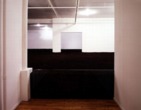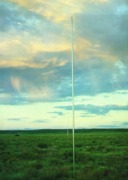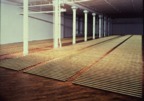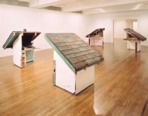This site is made possible by its sponsors. Please visit them!

Some examples:

Walter De Maria (American, 1935-), The New York
Earth Room, 1977, an interior earth sculpture: 250 cubic yards of
earth (197 cubic meters), 3,600 square feet of floor space (335
square meters), 22 inch depth of material
(56 centimeters), total weight
of sculpture: 280,000 lbs. (127,300 kilos), Dia Center for the
Arts, 141 Wooster Street, New York City.

Walter De Maria, The Lightning Field, 1977. Isolated in
and interacting with the high desert of southwestern New Mexico,
the sculpture consists of 400 stainless steel poles situated in a rectangular
grid array one mile by
one kilometer. A full experience of The Lightning Field
depends upon the opportunity to view it alone or with a small
group of people over an extended period of time. Dia Center for the Arts, which commissioned
and maintains The Lightning Field, schedules overnight
visits in advance, limiting groups to six or fewer persons.

Walter De Maria (American, 1935-), The Broken
Kilometer, 1979, 500 highly polished,
round, solid brass rods,
each measuring two meters
in length and five centimeters
(two inches) in diameter.
The 500 rods are placed in five parallel
rows of 100 rods each. The sculpture weighs
18 3/4 tons and would measure 3,280 feet if all the elements
were laid end-to-end. Each rod is placed such that the spaces
between the rods increase by 5 mm with each consecutive space,
from front to back; the first two rods of each row are placed
80 mm apart, the last two rods are placed 580 mm apart. Metal
halide stadium lights illuminate the work: width
45 feet, length 125 feet.
Dia Center for the Arts, 393 West Broadway in New York City.

Gordon Matta-Clark (American, 1943-1978),
Splitting: Four Corners, 1974, four building
fragments, approximately 57 x 42 x 42 inches (144.8 x 106.7 x
106.7 cm) each, San Francisco Museum of Modern Art. With a chainsaw,
Matta-Clark made cuts through entire buildings, and called actions
"interventions." He referred to the practice of exposing
ambiguities within familiar
spaces and ways of seeing
"anarchitecture." Most of which we can see today only
through photographic documentations,
although Splitting: Four Corners is an exception to that
rule.

Louise Bourgeois (American, born France,
1911-), Articulated Lair, 1986, painted steel, rubber, and metal,
overall 9 feet 3 inches x 21 feet 6 inches x 16 feet 1 inches
(281.7 x 655.7 x 555.6 cm), Museum of Modern Art, NY. See feminism and feminist art.
Also see conceptual art, entropy, gemütlichkeit, installation, interdisciplinary, measure and measurement, and nature.
https://inform.quest/_art
Copyright © 1996-![]()